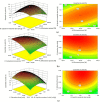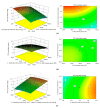Optimization and Characterization of Microwave-Assisted Hydro-Distillation Extraction of Essential Oils from Cinnamomum camphora Leaf and Recovery of Polyphenols from Extract Fluid
- PMID: 32674448
- PMCID: PMC7397326
- DOI: 10.3390/molecules25143213
Optimization and Characterization of Microwave-Assisted Hydro-Distillation Extraction of Essential Oils from Cinnamomum camphora Leaf and Recovery of Polyphenols from Extract Fluid
Abstract
In this study, the efficiency of microwave-assisted hydro-distillation (MAHD) to extract essential oil from Cinnamomum camphora leaf, and the recovery of polyphenols from extract fluid were investigated. The effects of microwave power, liquid-to-material ratio, and extraction time on the extraction efficiency were studied by a single factor test as well as the response surface methodology (RSM) based on the central composite design method. The optimal extraction conditions were a microwave power of 786.27 W, liquid-to-material ratio of 7.47:1 mL/g, and extraction time of 35.57 min. The yield of essential oil was 3.26 ± 0.05% (w/w), and the recovery of polyphenols was 4.97 ± 0.02 mg gallic acid equivalent/g dry weight under the optimal conditions. Furthermore, the comprehensive two-dimensional gas chromatography-time-of-flight mass spectrometry (GC×GC-TOFMS) was used to characterize the essential oils of fresh and fallen leaves, and 159 individual compounds were tentatively identified, accounting for more than 89.68 and 87.88% of the total contents, respectively. The main ingredients include sabinene, l-β-pinene, β-myrcene, α-terpineol, 3-heptanone, and β-thujene, as well as δ-terpineol and 3-heptanone, which were first identified in C. camphora essential oil. In conclusion, the MAHD method could extract essential oil from C. camphora with high efficiency, and the polyphenols could be obtained from the extract fluid at the same time, improving the utilization of C. camphora leaf.
Keywords: Cinnamomum camphora; GC×GC-TOFMS; essential oil; microwave-assisted extraction; polyphenols; response surface methodology.
Conflict of interest statement
The authors declare no conflict of interest.
Figures




Similar articles
-
The Chemical Composition of Essential Oils from Cinnamomum camphora and Their Insecticidal Activity against the Stored Product Pests.Int J Mol Sci. 2016 Nov 4;17(11):1836. doi: 10.3390/ijms17111836. Int J Mol Sci. 2016. PMID: 27827929 Free PMC article.
-
Essential Oils from Humulus Lupulus scCO₂ Extract by Hydrodistillation and Microwave-Assisted Hydrodistillation.Molecules. 2018 Nov 3;23(11):2866. doi: 10.3390/molecules23112866. Molecules. 2018. PMID: 30400271 Free PMC article.
-
The Chemical Profiling of Essential Oils from Different Tissues of Cinnamomum camphora L. and Their Antimicrobial Activities.Molecules. 2021 Aug 24;26(17):5132. doi: 10.3390/molecules26175132. Molecules. 2021. PMID: 34500567 Free PMC article.
-
Extraction of polyphenols and essential oils from herbs with green extraction methods - An insightful review.Food Chem. 2024 Dec 1;460(Pt 1):140456. doi: 10.1016/j.foodchem.2024.140456. Epub 2024 Jul 15. Food Chem. 2024. PMID: 39084104 Review.
-
Phytochemistry and Applications of Cinnamomum camphora Essential Oils.Molecules. 2022 Apr 22;27(9):2695. doi: 10.3390/molecules27092695. Molecules. 2022. PMID: 35566046 Free PMC article. Review.
Cited by
-
Enteric-Coated Cologrit Tablet Exhibit Robust Anti-Inflammatory Response in Ulcerative Colitis-like In-Vitro Models by Attuning NFκB-Centric Signaling Axis.Pharmaceuticals (Basel). 2022 Dec 31;16(1):63. doi: 10.3390/ph16010063. Pharmaceuticals (Basel). 2022. PMID: 36678560 Free PMC article.
-
Advances in extraction methods, chemical constituents, pharmacological activities, molecular targets and toxicology of volatile oil from Acorus calamus var. angustatus Besser.Front Pharmacol. 2022 Dec 1;13:1004529. doi: 10.3389/fphar.2022.1004529. eCollection 2022. Front Pharmacol. 2022. PMID: 36545308 Free PMC article. Review.
-
Impacts of Mechanical Injury on Volatile Emission Rate and Composition in 45 Subtropical Woody Broad-Leaved Storage and Non-Storage Emitters.Plants (Basel). 2025 Mar 6;14(5):821. doi: 10.3390/plants14050821. Plants (Basel). 2025. PMID: 40094813 Free PMC article.
-
Phytochemistry, pharmacological effects and mechanism of action of volatile oil from Panax ginseng C.A.Mey: a review.Front Pharmacol. 2024 Aug 13;15:1436624. doi: 10.3389/fphar.2024.1436624. eCollection 2024. Front Pharmacol. 2024. PMID: 39193331 Free PMC article. Review.
References
-
- Zhou H.X., Ren J.L., Li Z.H. Antibacterial activity and mechanism of pinoresinol from Cinnamomum camphora leaves against food-related bacteria. Food Control. 2017;79:192–199. doi: 10.1016/j.foodcont.2017.03.041. - DOI
-
- Wu L., Xiong W., Hu J.W., Wu J., Li Z.J., Gao Y., Liu D., Liu Y., Liu W., Liang M., et al. Secondary metabolites from the twigs of Cinnamomum camphora. Chem. Nat. Compd. 2019;55:345–347. doi: 10.1007/s10600-019-02686-8. - DOI
-
- Liu C.H., Mishra A.K., Tan R.X., Tang C., Yang H., Shen Y.F. Repellent and insecticidal activities of essential oils from Artemisia princeps and Cinnamomum camphora and their effect on seed germination of wheat and broad bean. Bioresour. Technol. 2006;97:1969–1973. doi: 10.1016/j.biortech.2005.09.002. - DOI - PubMed
-
- Srivastava B., Singh P., Shukla R., Dubey N.K. A novel combination of the essential oils of Cinnamomum camphora and Alpinia galanga in checking aflatoxin B-1 production by a toxigenic strain of Aspergillus flavus. World J. Microbiol. Biotechnol. 2008;24:693–697. doi: 10.1007/s11274-007-9526-0. - DOI
MeSH terms
Substances
Grants and funding
LinkOut - more resources
Full Text Sources

